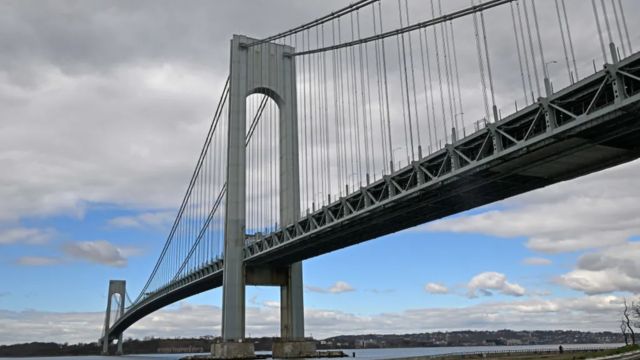A huge cargo ship experienced a loss of propulsion power in the waters near New York City and came to a stop close to the Verrazzano-Narrows Bridge on Friday night. This incident occurred less than two weeks after another large cargo vessel failed and collided with Baltimore’s Francis Scott Key Bridge.
The US Coast Guard has confirmed that the 89,000-ton M/V APL Qingdao experienced a loss of propulsion around 8:30 p.m. while navigating the Kill Van Kull waterway. This waterway serves as the shipping lane connecting Staten Island and Bayonne, New Jersey. The incident was reported to the Coast Guard’s Vessel Traffic Service.
John Konrad, the CEO of maritime-focused news outlet gCaptain, shared an image on X that displays the APL Qingdao, a massive 1,100-foot vessel, floating in close proximity to the bridge that connects Brooklyn and Staten Island.
In a breaking news report from @gCaptain, it has been revealed that the APL QINGDAO, a container ship, experienced a power loss while passing through New York harbor. According to a tugboat captain, who witnessed the incident, the ship had three escort tugs but required an additional three to regain control. Fortunately, the APL QINGDAO was able to regain power and was safely brought to anchor near the Verrazano Bridge. (Source: @gCaptain)
Three tug boats accompanied the APL Qingdao and provided guidance after the power failure, helping the vessel regain propulsion soon after.
The ship was positioned just north of the bridge and anchored in that location.
Salvage crews have initiated the process of removing containers from the ship responsible for the collapse of Baltimore’s Key Bridge.
The M/V APL Qingdao reported to Coast Guard Vessel Traffic Service New York that it had a loss of propulsion in the Kill Van Kull waterway around 8:30pm on Friday. Fortunately, the vessel was able to regain propulsion and with the assistance of three towing vessels, it safely anchored in Stapleton Anchorage, outside of the navigable channel just north of the Verrazano Bridge, according to the Coast Guard.
“These towing vessels were accompanying the vessel as a standard safety procedure, which is commonly done for large vessels when they are leaving their berth.”
The Kill Van Kull waterway, stretching for a mere 3 miles, serves as a narrow tidal strait that divides Newark Bay, the location of the Port Newark Container Terminal, and Upper New York Bay.
The waterway is one of the busiest in the Port of New York and New Jersey.
A tragic incident occurred in Florida when a segment of a construction crane collapsed onto a downtown bridge. One worker lost their life in the incident, while two others were rushed to the hospital for treatment. This unfortunate event highlights the dangers and risks that construction workers face on a daily basis. It serves as a reminder of the importance of strict safety protocols and measures to ensure the well-being of those working in the construction industry.
The Coast Guard mandated that the vessel’s propulsion system undergo certification to ensure that it had been repaired and was in perfect working condition.
In addition, the crew had to furnish a comprehensive casualty report, outlining the exact factors that led to the loss of propulsion.
Once the vessel had met those requirements, it was given permission to continue its journey to Charleston, South Carolina.
Sign up for our Metro Daily Newsletter by clicking here.
The image immediately reminds us of the tragic Francis Scott Key Bridge disaster in Baltimore last month. Six construction workers lost their lives when a cargo ship named Dali collided with one of the supports of the 1.9-mile bridge, causing it to collapse into the Patapsco River.
The collapse of the ground brought maritime transit to a standstill at the crucial Port of Baltimore. During an interview on CBS’ “Face the Nation” on Sunday morning, Maryland Governor Wes Moore expressed optimism, stating that it is quite possible for normal operations to resume on the waterway as early as May.
“We understand that the timeline is quite aggressive, but we are determined to work tirelessly to meet this deadline,” Moore assured.
The Dali seemed to experience a decrease in power leading up to the Baltimore crash.
In contrast, the APL Qingdao recently experienced a loss of propulsion.



